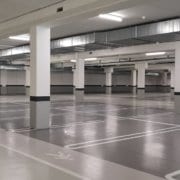Why Proximity to Public Transportation Is a Factor in Commercial Real Estate Development
Public transportation has become a valuable community amenity, increasing the functionality and attractiveness of neighborhoods and the buildings that surround them. In an effort to improve walkability and livability within dense downtown areas, many cities are dependent on public transportation, specifically metro and light rail. A study by Ernst & Young and the Urban Land Institute found that infrastructure, including transportation, is the most important factor influencing commercial real estate investment and development decisions around the world.
As transit systems become more efficient and proximity to mass transit becomes more desirable, public transportation is a factor that should be considered during the planning and developmental phases of new properties. Owners, developers, and investors who want to gain a competitive edge in the market understand the importance of monitoring today’s shifting transportation preferences and preparing for its impact on commercial real estate development both now and in the future.
Read ahead to learn why a close proximity to public transportation is a factor in today’s commercial real estate development.
Property Value
Proximity to public transportation plays a role in increasing commercial property value. According to a recent study of 7 metropolitan regions conducted by the American Public Transportation Association and the National Association of Realtors, 4 out of the 7 regions explored saw median sales prices per square foot increase between 5% and 42%. Properties placed near new infrastructure benefit the most in terms of property value, with an average price gap of 16.4% between a railway station zone and the average commercial property.
In addition to a higher price per square foot, commercial properties near transit systems typically appreciate in value more rapidly than those that are not. In fact, according to research conducted by Smart Growth America, a non-profit organization focused on how metropolitan expansion affects the environment and economic sustainability, commercial properties near transit systems in Central Business Districts had 4.5% higher net incomes, 10.4% higher market values, and 0.2% lower cap rates.
Tenant Attraction
Multifamily Tenants
Commercial properties that are centrally located and grant commuters access to multiple modes of transportation are becoming more and more attractive to tenants. This attraction is largely due to a growing desire amongst residents to live in or near areas with a close proximity to public transportation. Access to transit systems, including metro and light rail, provides residents with the option to bypass traffic, making it possible to get to their destinations quicker and with less of a hassle. Additionally, apartments with proximity to public transportation typically indicate the area’s walkability – a characteristic that many modern day tenants desire – and closeness to nearby restaurants, gyms, and shops.
Office Tenants
Companies whose offices are near public transportation facilities are more likely to attract talent than those who are not able to provide convenient access to transit systems. In fact, The State of the American Commute report, compiled by carpooling company, Scoop, revealed that 62% of United States workers did not apply for a particular job because of the commute. Additionally, 30% of employees have considered resigning from their positions because of a tedious daily commute.
As office buildings located near public transportation becomes one of the major factors for attracting talent, more companies are beginning to seek urban locations with convenient transportation options that will help them attract and retain employees. As talents’ demands shift, so do those of the companies who are hoping to attract them. Commercial real estate owners and developers must also consider this shift during the planning and developmental phases of a project to avoid losing the interests of current and potential tenants.
As urban living becomes more and more desirable, proximity to public transportation will continue to grow as an important factor in the demand for new commercial real estate development. People want to be able to live and work where they can easily access shops, restaurants, and other places that they enjoy visiting. The development of apartments and offices that are located near transit systems make this desire easier to fulfill.
Read Public Transportation Investments Lead to Growth for CRE to learn more about how public transportation impacts the present and future of commercial real estate.











